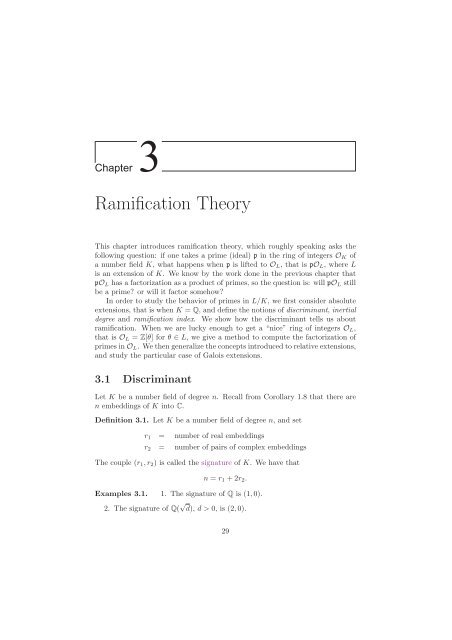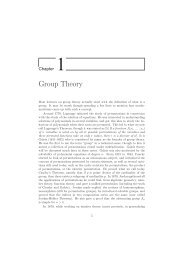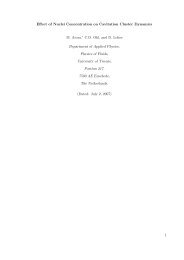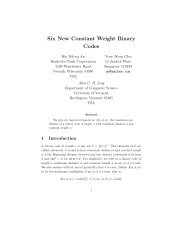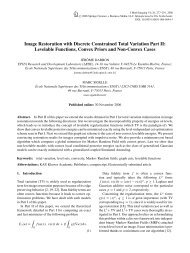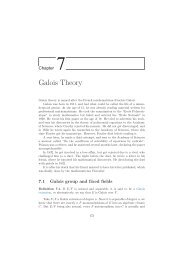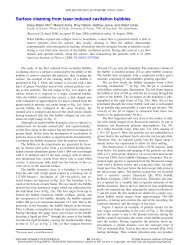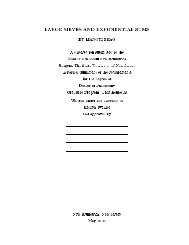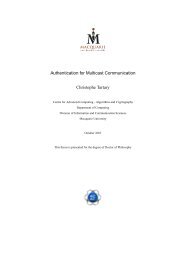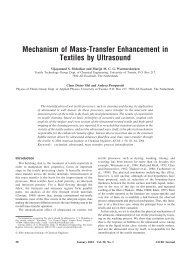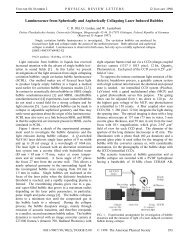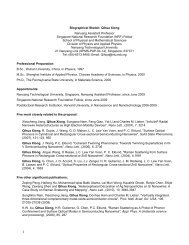Ramification Theory
Ramification Theory
Ramification Theory
Create successful ePaper yourself
Turn your PDF publications into a flip-book with our unique Google optimized e-Paper software.
Chapter 3<br />
<strong>Ramification</strong> <strong>Theory</strong><br />
This chapter introduces ramification theory, which roughly speaking asks the<br />
following question: if one takes a prime (ideal) p in the ring of integers OK of<br />
a number field K, what happens when p is lifted to OL, that is pOL, where L<br />
is an extension of K. We know by the work done in the previous chapter that<br />
pOL has a factorization as a product of primes, so the question is: will pOL still<br />
be a prime? or will it factor somehow?<br />
In order to study the behavior of primes in L/K, we first consider absolute<br />
extensions, that is when K = Q, and define the notions of discriminant, inertial<br />
degree and ramification index. We show how the discriminant tells us about<br />
ramification. When we are lucky enough to get a “nice” ring of integers OL,<br />
that is OL = Z[θ] for θ ∈ L, we give a method to compute the factorization of<br />
primes in OL. We then generalize the concepts introduced to relative extensions,<br />
and study the particular case of Galois extensions.<br />
3.1 Discriminant<br />
Let K be a number field of degree n. Recall from Corollary 1.8 that there are<br />
n embeddings of K into C.<br />
Definition 3.1. Let K be a number field of degree n, and set<br />
r1 = number of real embeddings<br />
r2 = number of pairs of complex embeddings<br />
The couple (r1,r2) is called the signature of K. We have that<br />
n = r1 + 2r2.<br />
Examples 3.1. 1. The signature of Q is (1,0).<br />
2. The signature of Q( √ d), d > 0, is (2,0).<br />
29
30 CHAPTER 3. RAMIFICATION THEORY<br />
3. The signature of Q( √ d), d < 0, is (0,1).<br />
4. The signature of Q( 3√ 2) is (1,1).<br />
Let K be a number field of degree n, and let OK be its ring of integers. Let<br />
σ1,...,σn be its n embeddings into C. We define the map<br />
σ : K → C n<br />
x ↦→ (σ1(x),...,σn(x)).<br />
Since OK is a free abelian group of rank n, we have a Z-basis {α1,...,αn} of<br />
OK. Let us consider the n × n matrix M given by<br />
M = (σi(αj))1≤i,j≤n.<br />
The determinant of M is a measure of the density of OK in K (actually of<br />
K/OK). It tells us how sparse the integers of K are. However, det(M) is only<br />
defined up to sign, and is not necessarily in either R or K. So instead we<br />
consider<br />
det(M 2 ) = det(M t M)<br />
<br />
n<br />
<br />
= det σk(αi)σk(αj)<br />
k=1<br />
i,j<br />
= det(Tr K/Q(αiαj))i,j ∈ Z,<br />
and this does not depend on the choice of a basis.<br />
Definition 3.2. Let α1,...,αn ∈ K. We define<br />
disc(α1,...,αn) = det(Tr K/Q(αiαj))i,j.<br />
In particular, if α1,...,αn is any Z-basis of OK, we write ∆K, and we call<br />
discriminant the integer<br />
∆K = det(Tr K/Q(αiαj))1≤i,j≤n.<br />
We have that ∆K = 0. This is a consequence of the following lemma.<br />
Lemma 3.1. The symmetric bilinear form<br />
is non-degenerate.<br />
K × K → Q<br />
(x,y) ↦→ Tr K/Q(xy)<br />
Proof. Let us assume by contradiction that there exists 0 = α ∈ K such that<br />
Tr K/Q(αβ) = 0 for all β ∈ K. By taking β = α −1 , we get<br />
Tr K/Q(αβ) = Tr K/Q(1) = n = 0.
3.2. PRIME DECOMPOSITION 31<br />
Now if we had that ∆K = 0, there would be a non-zero column vector<br />
(x1,...,xn) t , xi ∈ Q, killed by the matrix (Tr K/Q(αiαj))1≤i,j≤n. Set γ =<br />
n<br />
i=1 αixi, then Tr K/Q(αjγ) = 0 for each j, which is a contradiction by the<br />
above lemma.<br />
Example 3.2. Consider the quadratic field K = Q( √ 5). Its two embeddings<br />
into C are given by<br />
σ1 : a + b √ 5 ↦→ a + b √ 5, σ2 : a + b √ 5 ↦→ a − b √ 5.<br />
Its ring of integers is Z[(1 + √ 5)/2], so that the matrix M of embeddings is<br />
<br />
M =<br />
σ1(1)<br />
<br />
<br />
σ2(1)<br />
<br />
σ1<br />
1+ √ 5<br />
2<br />
and its discriminant ∆K can be computed by<br />
σ2<br />
1+ √ 5<br />
2<br />
∆K = det(M 2 ) = 5.<br />
3.2 Prime decomposition<br />
Let p be a prime ideal of O. Then p ∩Z is a prime ideal of Z. Indeed, one easily<br />
verifies that this is an ideal of Z. Now if a,b are integers with ab ∈ p ∩ Z, then<br />
we can use the fact that p is prime to deduce that either a or b belongs to p and<br />
thus to p ∩ Z (note that p ∩ Z is a proper ideal since p ∩ Z does not contain 1,<br />
and p ∩ Z = ∅, as N(p) belongs to p and Z since N(p) = |O/p| < ∞).<br />
Since p ∩ Z is a prime ideal of Z, there must exist a prime number p such<br />
that p ∩ Z = pZ. We say that p is above p.<br />
p ⊂ OK ⊂ K<br />
pZ ⊂ Z ⊂ Q<br />
We call residue field the quotient of a commutative ring by a maximal ideal.<br />
Thus the residue field of pZ is Z/pZ = Fp. We are now interested in the residue<br />
field OK/p. We show that OK/p is a Fp-vector space of finite dimension. Set<br />
φ : Z → OK → OK/p,<br />
where the first arrow is the canonical inclusion ι of Z into OK, and the second<br />
arrow is the projection π, so that φ = π ◦ ι. Now the kernel of φ is given by<br />
ker(φ) = {a ∈ Z | a ∈ p} = p ∩ Z = pZ,<br />
so that φ induces an injection of Z/pZ into OK/p, since Z/pZ ≃ Im(φ) ⊂ OK/p.<br />
By Lemma 2.1, OK/p is a finite set, thus a finite field which contains Z/pZ and<br />
we have indeed a finite extension of Fp.
32 CHAPTER 3. RAMIFICATION THEORY<br />
Definition 3.3. We call inertial degree, and we denote by fp, the dimension of<br />
the Fp-vector space O/p, that is<br />
Note that we have<br />
N(p) = |O/p| = |F<br />
fp = dimFp (O/p).<br />
dimFp (O/p)<br />
p<br />
| = |Fp| fp = p fp .<br />
Example 3.3. Consider the quadratic field K = Q(i), with ring of integers<br />
Z[i], and let us look at the ideal 2Z[i]:<br />
2Z[i] = (1 + i)(1 − i)Z[i] = p 2 , p = (1 + i)Z[i]<br />
since (−i)(1 + i) = 1 − i. Furthermore, p ∩ Z = 2Z, so that p = (1 + i) is said<br />
to be above 2. We have that<br />
N(p) = N K/Q(1 + i) = (1 + i)(1 − i) = 2<br />
and thus fp = 1. Indeed, the corresponding residue field is<br />
OK/p ≃ F2.<br />
Let us consider again a prime ideal p of O. We have seen that p is above<br />
the ideal pZ = p ∩ Z. We can now look the other way round: we start with the<br />
prime p ∈ Z, and look at the ideal pO of O. We know that pO has a unique<br />
factorization into a product of prime ideals (by all the work done in Chapter<br />
2). Furthermore, we have that p ⊂ p, thus p has to be one of the factors of pO.<br />
Definition 3.4. Let p ∈ Z be a prime. Let p be a prime ideal of O above p.<br />
We call ramification index of p, and we write ep, the exact power of p which<br />
divides pO.<br />
We start from p ∈ Z, whose factorization in O is given by<br />
pO = p ep 1<br />
1 · · · p epg<br />
g .<br />
We say that p is ramified if epi > 1 for some i. On the contrary, p is non-ramified<br />
if<br />
pO = p1 · · · pg, pi = pj, i = j.<br />
Both the inertial degree and the ramification index are connected via the degree<br />
of the number field as follows.<br />
Proposition 3.2. Let K be a number field and OK its ring of integers. Let<br />
p ∈ Z and let<br />
pO = p ep 1<br />
1 · · · p epg<br />
g<br />
be its factorization in O. We have that<br />
n = [K : Q] =<br />
g<br />
i=1<br />
epifpi .
3.2. PRIME DECOMPOSITION 33<br />
Proof. By Lemma 2.1, we have<br />
N(pO) = |N K/Q(p)| = p n ,<br />
where n = [K : Q]. Since the norm N is multiplicative (see Corollary 2.12), we<br />
deduce that<br />
N(p ep 1<br />
1 · · · p epg<br />
g<br />
g ) = N(pi) ep g<br />
i = p fp iep i.<br />
i=1<br />
There is, in general, no straightforward method to compute the factorization<br />
of pO. However, in the case where the ring of integers O is of the form O = Z[θ],<br />
we can use the following result.<br />
Proposition 3.3. Let K be a number field, with ring of integers OK, and let<br />
p be a prime. Let us assume that there exists θ such that O = Z[θ], and let f<br />
be the minimal polynomial of θ, whose reduction modulo p is denoted by ¯ f. Let<br />
¯f(X) =<br />
g<br />
i=1<br />
φi(X) ei<br />
be the factorization of f(X) in Fp[X], with φi(X) coprime and irreducible. We<br />
set<br />
pi = (p,fi(θ)) = pO + fi(θ)O<br />
where fi is any lift of φi to Z[X], that is ¯ fi = φi mod p. Then<br />
is the factorization of pO in O.<br />
pO = p e1<br />
1<br />
· · · peg g<br />
Proof. Let us first notice that we have the following isomorphism<br />
O/pO = Z[θ]/pZ[θ] ≃ Z[X]/f(X)<br />
p(Z[X]/f(X)) ≃ Z[X]/(p,f(X)) ≃ Fp[X]/ ¯ f(X),<br />
where ¯ f denotes f mod p. Let us call A the ring<br />
A = Fp[X]/ ¯ f(X).<br />
The inverse of the above isomorphism is given by the evaluation in θ, namely, if<br />
ψ(X) ∈ Fp[X], with ψ(X) mod ¯ f(X) ∈ A, and g ∈ Z[X] such that ¯g = ψ, then<br />
its preimage is given by g(θ). By the Chinese Theorem, recall that we have<br />
A = Fp[X]/ ¯ f(X) ≃<br />
i=1<br />
g<br />
Fp[X]/φi(X) ei ,<br />
since by assumption, the ideal ( ¯ f(X)) has a prime factorization given by ( ¯ f(X)) =<br />
g<br />
i=1 (φi(X)) ei .<br />
i=1
34 CHAPTER 3. RAMIFICATION THEORY<br />
We are now ready to understand the structure of prime ideals of both O/pO<br />
and A, thanks to which we will prove that pi as defined in the assumption is<br />
prime, that any prime divisor of pO is actually one of the pi, and that the power<br />
ei appearing in the factorization of ¯ f are bigger or equal to the ramification index<br />
epi of pi. We will then invoke the proposition that we have just proved to show<br />
that ei = epi , which will conclude the proof.<br />
By the factorization of A given above by the Chinese theorem, the maximal<br />
ideals of A are given by (φi(X))A, and the degree of the extension A/(φi(X))A<br />
over Fp is the degree of φi. By the isomorphism A ≃ O/pO, we get similarly<br />
that the maximal ideals of O/pO are the ideals generated by fi(θ) mod pO.<br />
We consider the projection π : O → O/pO. We have that<br />
π(pi) = π(pO + fi(θ)O) = fi(θ)O mod pO.<br />
Consequently, pi is a prime ideal of O, since fi(θ)O is. Furthermore, since<br />
pi ⊃ pO, we have pi | pO, and the inertial degree fpi = [O/pi : Fp] is the degree<br />
of φi, while epi denotes the ramification index of pi.<br />
Now, every prime ideal p in the factorization of pO is one of the pi, since<br />
the image of p by π is a maximal ideal of O/pO, that is<br />
pO = p ep 1<br />
1 · · · p epg<br />
g<br />
and we are thus left to look at the ramification index.<br />
The ideal φ ei<br />
i A of A belongs to O/pO via the isomorphism between O/pO ≃<br />
A, and its preimage in O by π−1 contains p ei<br />
i (since if α ∈ pei i , then α is a sum of<br />
products α1 · · · αei , whose image by π will be a sum of product π(α1) · · · π(αei )<br />
with π(αi) ∈ φiA). In O/pO, we have 0 = ∩ g<br />
i=1φi(θ) ei , that is<br />
pO = π −1 (0) = ∩ g<br />
i=1π−1 (φ ei<br />
i<br />
A) ⊃ ∩g<br />
i=1 pei<br />
i =<br />
We then have that this last product is divided by pO = p ep i<br />
i , that is ei ≥ epi .<br />
Let n = [K : Q]. To show that we have equality, that is ei = epi , we use the<br />
previous proposition:<br />
n = [K : Q] =<br />
g<br />
i=1<br />
epifpi ≤<br />
g<br />
i=1<br />
p ei<br />
i .<br />
g<br />
ei deg(φi) = dimFp (A) = dimFp Zn /pZ n = n.<br />
i=1<br />
The above proposition gives a concrete method to compute the factorization<br />
of a prime pOK:<br />
1. Choose a prime p ∈ Z whose factorization in pOK is to be computed.<br />
2. Let f be the minimal polynomial of θ such that OK = Z[θ].
3.2. PRIME DECOMPOSITION 35<br />
3. Compute the factorization of ¯ f = f mod p:<br />
¯f =<br />
g<br />
φi(X) ei .<br />
i=1<br />
4. Lift each φi in a polynomial fi ∈ Z[X].<br />
5. Compute pi = (p,fi(θ)) by evaluating fi in θ.<br />
6. The factorization of pO is given by<br />
pO = p e1<br />
1<br />
· · · peg<br />
g .<br />
Examples 3.4. 1. Let us consider K = Q( 3√ 2), with ring of integers OK =<br />
Z[ 3√ 2]. We want to factorize 5OK. By the above proposition, we compute<br />
We thus get that<br />
X 3 − 2 ≡ (X − 3)(X 2 + 3X + 4)<br />
≡ (X + 2)(X 2 − 2X − 1) mod 5.<br />
5OK = p1p2, p1 = (5,2 + 3√ 2), p2 = (5, 3√ 4 − 2 3√ 2 − 1).<br />
2. Let us consider Q(i), with OK = Z[i], and choose p = 2. We have θ = i<br />
and f(X) = X 2 + 1. We compute the factorization of ¯ f(X) = f(X)<br />
mod 2:<br />
X 2 + 1 ≡ X 2 − 1 ≡ (X − 1)(X + 1) ≡ (X − 1) 2 mod 2.<br />
We can take any lift of the factors to Z[X], so we can write<br />
2OK = (2,i − 1)(2,i + 1) or 2 = (2,i − 1) 2<br />
which is the same, since (2,i − 1) = (2,1 + i). Furthermore, since 2 =<br />
(1 − i)(1 + i), we see that (2,i − 1) = (1 + i), and we recover the result of<br />
Example 3.3.<br />
Definition 3.5. We say that p is inert if pO is prime, in which case we have<br />
g = 1, e = 1 and f = n. We say that p is totally ramified if e = n, g = 1, and<br />
f = 1.<br />
The discriminant of K gives us information on the ramification in K.<br />
Theorem 3.4. Let K be a number field. If p is ramified, then p divides the<br />
discriminant ∆K.
36 CHAPTER 3. RAMIFICATION THEORY<br />
Proof. Let p | pO be an ideal such that p 2 | pO (we are just rephrasing the fact<br />
that p is ramified). We can write pO = pI with I divisible by all the primes<br />
above p (p is voluntarily left as a factor of I). Let α1,...,αn ∈ O be a Z-basis<br />
of O and let α ∈ I but α ∈ pO. We write<br />
α = b1α1 + ... + bnαn, bi ∈ Z.<br />
Since α ∈ pO, there exists a bi which is not divisible by p, say b1. Recall that<br />
⎛<br />
σ1(α1)<br />
⎜<br />
∆K = det<br />
.<br />
⎝ .<br />
...<br />
⎞2<br />
σ1(αn)<br />
.<br />
⎟<br />
. ⎠<br />
σn(α1) ... σn(αn)<br />
where σi, i = 1,...,n are the n embeddings of K into C. Let us replace α1 by<br />
α, and set<br />
⎛<br />
σ1(α)<br />
⎜<br />
D = det<br />
.<br />
⎝ .<br />
...<br />
⎞2<br />
σ1(αn)<br />
.<br />
⎟<br />
. ⎠ .<br />
σn(α) ... σn(αn)<br />
Now D and ∆K are related by<br />
D = ∆Kb 2 1,<br />
since D can be rewritten as<br />
⎛<br />
⎛<br />
⎜ σ1(α1)<br />
⎜⎜<br />
D = det<br />
.<br />
⎜⎝<br />
.<br />
⎝ .<br />
σn(α1)<br />
...<br />
...<br />
⎛<br />
⎞ b1<br />
σ1(αn) ⎜ b2 .<br />
⎟ ⎜<br />
. ⎠ ⎜<br />
⎝<br />
σn(αn)<br />
bn<br />
0<br />
1<br />
...<br />
. ..<br />
...<br />
⎞⎞2<br />
0<br />
0 ⎟⎟<br />
⎟⎟<br />
⎟⎟<br />
.<br />
⎠⎠<br />
1<br />
We are thus left to prove that p | D, since by construction, we have that p does<br />
not divide b 2 1.<br />
Intuitively, the trick of this proof is to replace proving that p|∆K where we<br />
have no clue how the factor p appears, with proving that p|D, where D has been<br />
built on purpose as a function of a suitable α which we will prove below is such<br />
that all its conjugates are above p.<br />
Let L be the Galois closure of K, that is, L is a field which contains K, and<br />
which is a normal extension of Q. The conjugates of α all belong to L. We<br />
know that α belongs to all the primes of OK above p. Similarly, α ∈ K ⊂ L<br />
belongs to all primes P of OL above p. Indeed, P ∩ OK is a prime ideal of OK<br />
above p, which contains α.<br />
We now fix a prime P above p in OL. Then σi(P) is also a prime ideal of<br />
OL above p (σi(P) is in L since L/Q is Galois, σi(P) is prime since P is, and<br />
p = σi(p) ∈ σi(P)). We have that σi(α) ∈ P for all σi, thus the first column of<br />
the matrix involves in the computation of D is in P, so that D ∈ P and D ∈ Z,<br />
to get<br />
D ∈ P ∩ Z = pZ.
3.3. RELATIVE EXTENSIONS 37<br />
We have just proved that if p is ramified, then p|∆K. The converse is also<br />
true.<br />
Examples 3.5. 1. We have seen in Example 3.2 that the discriminant of<br />
K = Q( √ 5) is ∆K = 5. This tells us that only 5 is ramified in Q( √ 5).<br />
2. In Example 3.3, we have seen that 2 ramifies in K = Q(i). So 2 should<br />
appear in ∆K. One can actually check that ∆K = −4.<br />
Corollary 3.5. There is only a finite number of ramified primes.<br />
Proof. The discriminant only has a finite number of divisors.<br />
3.3 Relative Extensions<br />
Most of the theory seen so far assumed that the base field is Q. In most cases,<br />
this can be generalized to an arbitrary number field K, in which case we consider<br />
a number field extension L/K. This is called a relative extension. By contrast,<br />
we may call absolute an extension whose base field is Q. Below, we will generalize<br />
several definitions previously given for absolute extensions to relative<br />
extensions.<br />
Let K be a number field, and let L/K be a finite extension. We have<br />
correspondingly a ring extension OK → OL. If P is a prime ideal of OL, then<br />
p = P ∩ OK is a prime ideal of OK. We say that P is above p. We have a<br />
factorization<br />
pOL =<br />
g<br />
i=1<br />
P ePi |p<br />
i ,<br />
where e Pi/p is the relative ramification index. The relative inertial degree is<br />
given by<br />
f Pi|p = [OL/Pi : OK/p].<br />
We still have that<br />
[L : K] = e P|pf P|p<br />
where the summation is over all P above p.<br />
Let M/L/K be a tower of finite extensions, and let P,P,p be prime ideals<br />
of respectively M, L, and K. Then we have that<br />
f P|p = f P|Pf P|p<br />
e P|p = e P|Pe P|p.<br />
Let IK, IL be the groups of fractional ideals of K and L respectively. We<br />
can also generalize the application norm as follows:<br />
N : IL → IK<br />
P ↦→ p f P|p ,
38 CHAPTER 3. RAMIFICATION THEORY<br />
which is a group homomorphism. This defines a relative norm for ideals, which<br />
is itself an ideal!<br />
In order to generalize the discriminant, we would like to have an OK-basis<br />
of OL (similarly to having a Z-basis of OK), however such a basis does not exist<br />
in general. Let α1,...,αn be a K-basis of L where αi ∈ OL, i = 1,...,n. We<br />
set<br />
⎛<br />
⎞<br />
σ1(α1)<br />
⎜<br />
discL/K(α1,...,αn) = det<br />
.<br />
⎝ .<br />
... σn(α1)<br />
.<br />
σ1(αn) ... σn(αn)<br />
where σi : L → C are the embeddings of L into C which fix K. We define<br />
∆ L/K as the ideal generated by all disc L/K(α1,...,αn). It is called relative<br />
discriminant.<br />
3.4 Normal Extensions<br />
Let L/K be a Galois extension of number fields, with Galois group G = Gal(L/K).<br />
Let p be a prime of OK. If P is a prime above p in OL, and σ ∈ G, then σ(P)<br />
is a prime ideal above p. Indeed, σ(P) ∩ OK ⊂ K, thus σ(P) ∩ OK = P ∩ OK<br />
since K is fixed by σ.<br />
Theorem 3.6. Let<br />
pOL =<br />
g<br />
i=1<br />
be the factorization of pOL in OL. Then G acts transitively on the set {P1,...,Pg}.<br />
Furthermore, we have that<br />
and<br />
P ei<br />
i<br />
e1 = ... = eg = e where ei = e Pi|p<br />
f1 = ... = fg = f where fi = f Pi|p<br />
[L : K] = efg.<br />
Proof. G acts transitively. Let P be one of the Pi. We need to prove that<br />
there exists σ ∈ G such that σ(Pj) = P for Pj any other of the Pi. In the proof<br />
of Corollary 2.10, we have seen that there exists β ∈ P such that βOLP −1 is<br />
an integral ideal coprime to pOL. The ideal<br />
I = <br />
σ(βOLP −1 )<br />
σ∈G<br />
is an integral ideal of OL (since βOLP −1 is), which is furthermore coprime to<br />
pOL (since σ(βOLP −1 ) and σ(pOL) are coprime and σ(pOL) = σ(p)σ(OL) =<br />
pOL).<br />
2<br />
⎟<br />
⎠
3.4. NORMAL EXTENSIONS 39<br />
Thus I can be rewritten as<br />
and we have that<br />
I =<br />
<br />
σ∈G σ(β)OL<br />
<br />
σ∈G σ(P)<br />
= NL/K(β)OL <br />
σ∈G σ(P)<br />
I <br />
σ(P) = NL/K(β)OL. σ∈G<br />
Since NL/K(β) = <br />
σ∈G σ(β), β ∈ P and one of the σ is the identity, we have<br />
that NL/K(β) ∈ P. Furthermore, NL/K(β) ∈ OK since β ∈ OL, and we get<br />
that NL/K(β) ∈ P ∩ OK = p, from which we deduce that p divides the right<br />
hand side of the above equation, and thus the left hand side. Since I is coprime<br />
to p, we get that p divides <br />
σ∈G σ(P). In other words, using the factorization<br />
of p, we have that<br />
<br />
σ(P) is divisible by pOL =<br />
σ∈G<br />
and each of the Pi has to be among {σ(P)}σ∈G.<br />
All the ramification indices are equal. By the first part, we know that<br />
there exists σ ∈ G such that σ(Pi) = Pk, i = k. Now, we have that<br />
σ(pOL) =<br />
g<br />
i=1<br />
σ(Pi) ei<br />
= pOL<br />
g<br />
= P ei<br />
i<br />
where the second equality holds since p ∈ OK and L/K is Galois. By comparing<br />
the two factorizations of p and its conjugates, we get that ei = ek.<br />
All the inertial degrees are equal. This follows from the fact that σ<br />
induces the following field isomorphism<br />
Finally we have that<br />
For now on, let us fix P above p.<br />
i=1<br />
OL/Pi ≃ OL/σ(Pi).<br />
|G| = [L : K] = efg.<br />
Definition 3.6. The stabilizer of P in G is called the decomposition group,<br />
given by<br />
D = D P/p = {σ ∈ G | σ(P) = P} < G.<br />
g<br />
i=1<br />
P ei<br />
i
40 CHAPTER 3. RAMIFICATION THEORY<br />
The index [G : D] must be equal to the number of elements in the orbit GP<br />
of P under the action of G, that is [G : D] = |GP| (this is the orbit-stabilizer<br />
theorem).<br />
By the above theorem, we thus have that [G : D] = g, where g is the number<br />
of distinct primes which divide pOL. Thus<br />
and<br />
n = efg<br />
= ef |G|<br />
|D|<br />
|D| = ef.<br />
If P ′ is another prime ideal above p, then the decomposition groups D P/p<br />
and D P ′ /p are conjugate in G via any Galois automorphism mapping P to P ′<br />
(in formula, we have that if P ′ = τ(P), then τD P/pτ −1 = D τ(P)/p).<br />
Proposition 3.7. Let D = D P/p be the decomposition group of P. The subfield<br />
L D = {α ∈ L | σ(α) = α, σ ∈ D}<br />
is the smallest subfield M of L such that (P∩OM)OL does not split. It is called<br />
the decomposition field of P.<br />
Proof. We first prove that L/L D has the property that(P ∩ O L D)OL does not<br />
split. We then prove its minimality.<br />
We know by Galois theory that Gal(L/L D ) is given by D. Furthermore, the<br />
extension L/L D is Galois since L/K is. Let Q = P ∩ O L D be a prime below P.<br />
By Theorem 3.6, we know that D acts transitively on the set of primes above<br />
Q, among which is P. Now by definition of D = D P/p, we know that P is fixed<br />
by D. Thus there is only P above Q.<br />
Let us now prove the minimality of L D . Assume that there exists a field<br />
M with L/M/K, such that Q = P ∩ OM has only one prime ideal of OL<br />
above it. Then this unique ideal must be P, since by definition P is above<br />
Q. Then Gal(L/M) is a subgroup of D, since its elements are fixing P. Thus<br />
M ⊃ L D .<br />
L ⊃ P<br />
n<br />
g D<br />
L D ⊃ Q<br />
g G/D<br />
K ⊃ p
3.4. NORMAL EXTENSIONS 41<br />
terminology e f g<br />
inert 1 n 1<br />
totally ramified n 1 1<br />
(totally) split 1 1 n<br />
Table 3.1: Different prime behaviors<br />
The next proposition uses the same notation as the above proof.<br />
Proposition 3.8. Let Q be the prime of L D below P. We have that<br />
f Q/p = e Q/p = 1.<br />
If D is a normal subgroup of G, then p is completely split in L D .<br />
Proof. We know that [G : D] = g(P/p) which is equal to [L D : K] by Galois<br />
theory. The previous proposition shows that g(P/Q) = 1 (recall that g counts<br />
how many primes are above). Now we compute that<br />
Since we have that<br />
and [L D : K] = g(P/p), we further get<br />
e(P/Q)f(P/Q) = [L : LD ]<br />
g(P/Q)<br />
= [L : L D ]<br />
= [L : K]<br />
[LD : K] .<br />
[L : K] = e(P/p)f(P/p)g(P/p)<br />
e(P/Q)f(P/Q) = e(P/p)f(P/p)g(P/p)<br />
g(P/p)<br />
= e(P/p)f(P/p)<br />
= e(P/Q)f(P/Q)e(Q/p)f(Q/p)<br />
where the last equality comes from transitivity. Thus<br />
e(Q/p)f(Q/p) = 1<br />
and e(Q/p) = f(Q/p) = 1 since they are positive integers.<br />
If D is normal, we have that L D /K is Galois. Thus<br />
and p completely splits.<br />
[L D : K] = e(Q/p)f(Q/p)g(Q/p) = g(Q/p)
42 CHAPTER 3. RAMIFICATION THEORY<br />
Let σ be in D. Then σ induces an automorphism of OL/P which fixes<br />
OK/p = Fp. That is we get an element φ(σ) ∈ Gal(FP/Fp). We have thus<br />
constructed a map<br />
φ : D → Gal(FP/Fp).<br />
This is a group homomorphism. We know that Gal(FP/Fp) is cyclic, generated<br />
by the Frobenius automorphism defined by<br />
FrobP(x) = x q , q = |Fp|.<br />
Definition 3.7. The inertia group I = I P/p is defined as being the kernel of φ.<br />
Example 3.6. Let K = Q(i) and OK = Z[i]. We have that K/Q is a Galois<br />
extension, with Galois group G = {1,σ} where σ : a + ib ↦→ a − ib.<br />
• We have that<br />
(2) = (1 + i) 2 Z[i],<br />
thus the ramification index is e = 2. Since efg = n = 2, we have that<br />
f = g = 1. The residue field is Z[i]/(1 + i)Z[i] = F2. The decomposition<br />
group D is G since σ((1+i)Z[i]) = (1+i)Z[i]. Since f = 1, Gal(F2/F2) =<br />
{1} and φ(σ) = 1. Thus the kernel of φ is D = G and the inertia group is<br />
I = G.<br />
• We have that<br />
(13) = (2 + 3i)(2 − 3i),<br />
thus the ramification index is e = 1. Here D = 1 for (2 ± 3i) since<br />
σ((2+3i)Z[i]) = (2−3i)Z[i] = (2+3i)Z[i]. We further have that g = 2, thus<br />
efg = 2 implies that f = 1, which as for 2 implies that the inertia group is<br />
I = G. We have that the residue field for (2±3i) is Z[i]/(2±3i)Z[i] = F13.<br />
• We have that (7)Z[i] is inert. Thus D = G (the ideal belongs to the base<br />
field, which is fixed by the whole Galois group). Since e = g = 1, the<br />
inertial degree is f = 2, and the residue field is Z[i]/(7)Z[i] = F49. The<br />
Galois group Gal(F49/F7) = {1,τ} with τ : x ↦→ x 7 , x ∈ F49. Thus the<br />
inertia group is I = {1}.<br />
We can prove that φ is surjective and thus get the following exact sequence:<br />
1 → I → D → Gal(FP/Fp) → 1.<br />
The decomposition group is so named because it can be used to decompose<br />
the field extension L/K into a series of intermediate extensions each of which<br />
has a simple factorization behavior at p. If we denote by L I the fixed field of I,<br />
then the above exact sequence corresponds under Galois theory to the following
3.4. NORMAL EXTENSIONS 43<br />
tower of fields:<br />
L ⊃ P<br />
e<br />
f<br />
L I<br />
L D<br />
g<br />
K ⊃ p<br />
Intuitively, this decomposition of the extension says that L D /K contains all<br />
of the factorization of p into distinct primes, while the extension L I /L D is the<br />
source of all the inertial degree in P over p. Finally, the extension L/L I is<br />
responsible for all of the ramification that occurs over p.<br />
Note that the map φ plays a special role for further theories, including<br />
reciprocity laws and class field theory.<br />
The main definitions and results of this chapter are<br />
• Definition of discriminant, and that a prime ramifies if and<br />
only if it divides the discriminant.<br />
• Definition of signature.<br />
• The terminology relative to ramification: prime<br />
above/below, inertial degree, ramification index, residue<br />
field, ramified, inert, totally ramified, split.<br />
• The method to compute the factorization if OK = Z[θ].<br />
• The formula [L : K] = g<br />
i=1 eifi.<br />
• The notion of absolute and relative extensions.<br />
• If L/K is Galois, that the Galois group acts transitively on<br />
the primes above a given p, that [L : K] = efg, and the<br />
concepts of decomposition group and inertia group.
44 CHAPTER 3. RAMIFICATION THEORY


